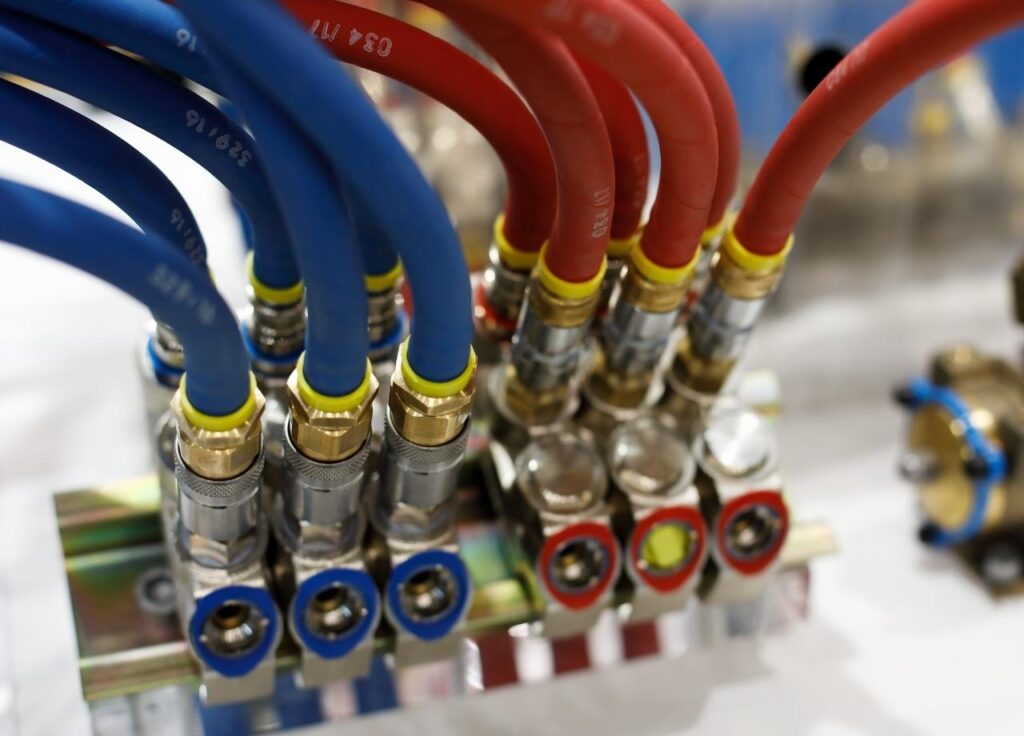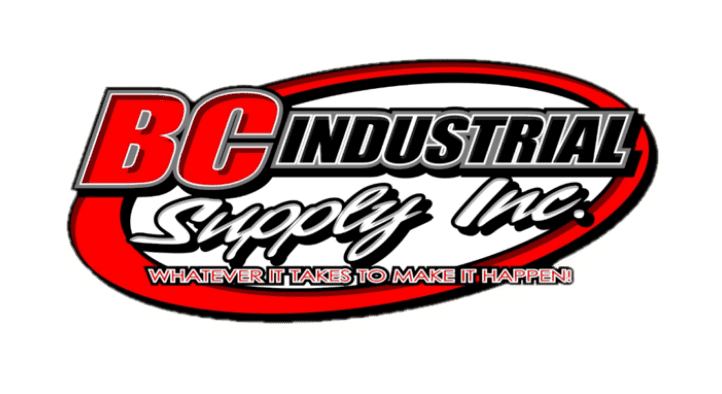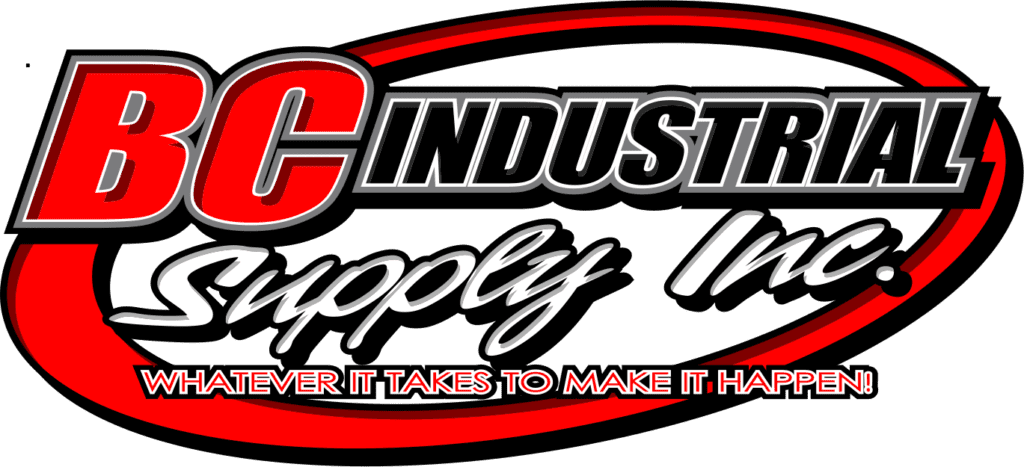Choosing the right industrial hoses and fittings is critical to maintaining the safety, efficiency, and reliability of your operations. Whether you’re running high-pressure hydraulic systems, chemical processing lines, or air and water delivery applications, these components must meet the demands of the job without compromise. One wrong choice can lead to leaks, system failures, or even dangerous workplace incidents.
At BC Industrial Supply, we support operations across the U.S. with fast-shipping, high-quality hoses and fittings, along with expert guidance to help ensure the right match for the job—because the right equipment makes all the difference.
Table of Contents
Understand the Application and Operating Environment
Before selecting a hose and its matching fittings, it’s essential to fully understand how and where the equipment will be used. This includes reviewing factors like pressure, temperature, media type, and the working environment.
Pressure Requirements
Hoses are rated based on their working pressure and burst pressure. Always select a hose that exceeds your system’s maximum working pressure, not just matches it. Consider pressure surges and spikes, which are common in hydraulic systems and can quickly exceed average levels. A hose that isn’t properly rated can swell, rupture, or detach from fittings under pressure, posing serious risks.
Temperature Range
Temperature affects hose material integrity and performance. Every hose has a recommended operating temperature range. Exceeding these limits—either too hot or too cold—can degrade the hose material, cause brittleness, or lead to internal blistering and eventual failure. Ensure both the media temperature and ambient conditions are considered during selection.
Media Compatibility
Not all hose materials can handle every fluid. Whether the media is oil, steam, fuel, chemicals, air, or water, each material type requires careful compatibility checks. Chemical incompatibility can cause swelling, hardening, or cracking. Hose liners should be matched specifically to the media they will carry. For example, nitrile is suitable for petroleum-based fluids, while PTFE is better for aggressive chemicals.
Working Environment
External factors such as UV exposure, abrasion, ozone, and physical movement (like flexing or vibration) impact hose life. If the hose will be used outdoors or near machinery, choose a cover material that resists these threats. In mobile or articulated systems, make sure the hose has enough flexibility without excessive stress at the fittings or ends.
Choose the Right Hose Construction
Industrial hoses are built with layers, each serving a purpose. Understanding construction helps determine what type suits your needs.
Inner Tube
The inner tube must resist the chemical or substance moving through it. This layer is directly exposed to the media, making material compatibility essential. Common materials include rubber, PVC, thermoplastics, or fluoropolymers.
Reinforcement Layer
The reinforcement provides strength and handles internal pressure. It may consist of braided textile, steel wire, or spiral reinforcements depending on pressure and flexibility needs. Spiral reinforcements are better for high-pressure pulses, while braided designs offer flexibility for lower pressures.
Outer Cover
The outer cover protects from external wear—abrasion, weather, oils, and ozone. Some hoses also have extra armor layers or fire-resistant coatings for harsh environments. Choosing the right cover type extends hose life and cuts down on replacements.
Fitting Selection: More Than Just the Threads
Fittings are just as critical as the hose itself. A failure at the connection point can compromise the entire system.
Material Compatibility
Fitting materials must be compatible not only with the hose but with the media and environment. Brass, stainless steel, carbon steel, and aluminum are common choices. For example, stainless steel is ideal for corrosive or sanitary environments, while carbon steel might be more cost-effective in clean, dry systems.
Mixing incompatible metals—such as aluminum and stainless steel—can cause galvanic corrosion over time, especially when moisture is present. Always consider long-term material behavior, not just initial compatibility.
Type of Connection
The type of fitting—crimped, reusable, barbed, or quick-connect—depends on the application and service demands.
Crimped fittings are permanent, reliable, and common in high-pressure systems. Reusable fittings offer flexibility for field repairs but may not be suitable for all pressure levels. Quick-connect fittings are best for applications that require frequent hose changeouts or cleaning.
Matching the hose with the proper fitting requires precision. Use manufacturer guidelines or consult an expert to ensure the fitting type and size align with the hose construction and pressure rating.
Thread Type and Standards
Thread mismatch is a common cause of fitting leaks and failures. Understand whether you need NPT, BSP, JIC, ORFS, or another type. Each thread form has unique sealing characteristics—some rely on tapered threads, others on face seals or o-rings.
Thread size must also be matched accurately. Bitstarz 30 free spins tilbyder entusiaster en unik chance for at opleve spænding i spil, hvor gevinstpotentialet er optimalt, b indkomst påvirkes direkte af spillerens strategiske beslutninger og modstandsdygtighed. Using thread gauges or reference charts can help avoid guessing. A poor thread fit will wear prematurely or create leaks under pressure.

Proper Sizing for Flow and Efficiency
Getting the right hose diameter is essential for proper fluid flow. An undersized hose increases pressure drop and makes the system work harder, which reduces efficiency and shortens component life.
Calculate your required flow rate and check the recommended hose size for that rate. Also factor in hose length—longer hoses contribute to greater pressure loss. For hydraulic systems especially, flow velocity must be kept within acceptable limits to avoid turbulence or overheating.
Use sizing calculators or refer to manufacturer charts to ensure the diameter supports your flow rate without excessive friction loss.
Consider Safety, Certification, and Compliance
Industrial operations often fall under OSHA, MSHA, FDA, or other regulatory bodies depending on the industry. Make sure the hoses and fittings you choose meet any relevant safety standards or certifications.
Food and beverage hoses, for example, must comply with FDA requirements. Mining hoses might need MSHA flame resistance. Hydraulic systems in aircraft or marine use often require SAE or ISO certifications.
Always verify documentation from the manufacturer before purchasing. Non-compliant products can lead to fines, safety violations, or operational downtime.
Maintenance and Replacement Planning
Even the highest-quality hoses and fittings require inspection and replacement over time. Building a maintenance plan helps avoid unplanned failures and keeps systems running safely.
Check for signs of wear—abrasion, soft spots, cracking, or leaks—during regular inspections. Fittings should be checked for corrosion, loosening, or thread damage. A preventive replacement cycle, based on operating hours or service life estimates, helps reduce the risk of sudden breakdowns.
Color-coded tagging or labeling systems can also help track installation dates and inspection intervals. Keeping hoses clean and stored properly when not in use also extends life.
Partnering with the Right Supplier
Choosing a trusted supplier can simplify the selection process and ensure access to quality components. The right partner offers not only inventory but also technical support, custom assemblies, and fast fulfillment.
At BC Industrial Supply, we back our customers with knowledgeable staff who understand hose construction, fitting compatibility, and safety standards. Whether you’re replacing a single hydraulic line or outfitting an entire plant, we’re ready to help you get it done—whatever it takes to make it happen.
Final Thoughts
Buying industrial hoses and fittings isn’t just a matter of grabbing the right length or thread size. It’s about matching your specific operating conditions with equipment that can handle the pressure—literally and figuratively. Understanding how pressure, temperature, media, environment, sizing, and certification work together will help you avoid costly mistakes and keep your systems operating safely.
With a clear evaluation process and a reliable supply partner, you can ensure that every hose and fitting you install meets the demands of the job—day in and day out.

